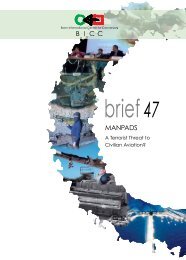egypt-final-presidential-elections-2012
egypt-final-presidential-elections-2012
egypt-final-presidential-elections-2012
You also want an ePaper? Increase the reach of your titles
YUMPU automatically turns print PDFs into web optimized ePapers that Google loves.
The Carter Center<br />
Election Day<br />
Voting is a fundamental exercise of a citizen’s<br />
political rights. The accuracy of the procedures<br />
and process by which these votes are<br />
aggregated is not only essential to the full expression<br />
of popular will but is also critical to ensure the rights<br />
of citizens to both elect and be elected. 149<br />
Throughout the <strong>presidential</strong> election process, a<br />
judge presided over each of Egypt’s polling stations.<br />
There were a total of 13,097 polling stations during<br />
the first round of voting, and a total of 13,099 polling<br />
stations reported during the second round. 150 In nearly<br />
all cases, a polling station had up to 6,000 voters<br />
allocated to it. 151 During both rounds, voting occurred<br />
between 8 a.m. and 9 p.m. over two consecutive days<br />
of polling, with the PEC extending the voting process<br />
for one additional hour to 10 p.m. during the second<br />
round’s last day of voting.<br />
The following observations are summarized from<br />
the nearly 1,900 polling station visits conducted by<br />
Carter Center witnesses across Egypt on the four days<br />
of voting and during subsequent aggregation over the<br />
two rounds of voting.<br />
Poll Opening<br />
Delays in Opening of Polling Stations: Delays in<br />
opening of polling stations were common in both the<br />
first and second rounds of polling. During the first<br />
round of the <strong>presidential</strong> election, less than one-third<br />
of polling stations visited by Carter Center witnesses<br />
opened on schedule at 8 a.m., and just under twothirds<br />
opened by 9 a.m. There was slight improvement<br />
witnessed during the second round. While less<br />
than one-third of polling stations visited by witnesses<br />
had opened on schedule at 8 a.m., all polling stations<br />
observed by Carter Center witnesses opened by<br />
9 a.m. Delays were generally caused by polling staff<br />
and judges arriving late to polling stations or by the<br />
slow setup of polling stations in those cases where<br />
staff members were in place on time. Reiterating<br />
the necessity of training as noted above, The Carter<br />
Center strongly recommends that in the future,<br />
Egypt’s election management bodies should attempt<br />
to organize a full cascade training program that<br />
emphasizes the importance of timely opening of the<br />
polls and provides better instruction on how to properly<br />
and efficiently set up a polling station.<br />
Additional Procedural Irregularities During<br />
Opening of the Polls: Additional procedure irregularities<br />
during the opening of the polls arose in several<br />
cases. Some judges incorrectly recorded numbers of<br />
ballot books and ballot box seals on the first day.<br />
Witness and candidate agents were unable to confirm<br />
the ballot box seal numbers in a few cases at the<br />
opening of the polling on the second day of the first<br />
round. Also, Carter Center witnesses reported irregularities<br />
such as poor room configuration, staff not<br />
wearing proper identification, or failure to follow all<br />
procedures in sealing ballot boxes, in some instances.<br />
Such cases were rarer during the second round.<br />
Despite late openings and procedural irregularities,<br />
Carter Center witnesses reported that, overall, the<br />
majority of poll openings were administered well.<br />
149 U.N., ICCPR, Article 25 (b)<br />
150 Two polling stations were added to the Aziz Abaza polling center in<br />
Heliopolis, Cairo, due to overcrowding in the first round.<br />
151 Polling stations were classified into three categories for logistical<br />
purposes. The first category of polling stations accommodated less than<br />
2,000 voters; the second between 2,001 and 4,000 voters; and the third<br />
category between 4,001 and 6,000 voters. However, in a few exceptional<br />
cases, in very remote or very densely populated places, the number of<br />
voters allocated to polling stations was as low as a few hundred voters and,<br />
conversely, some had more than 6,000 voters.<br />
52



